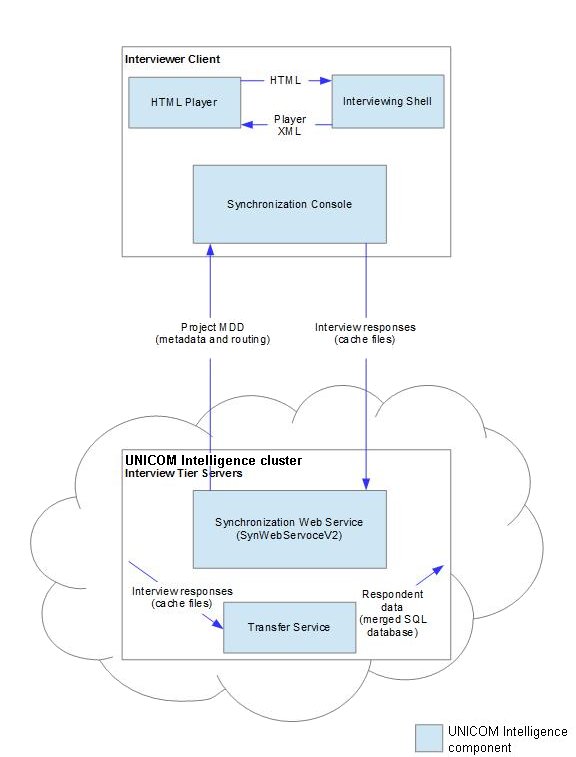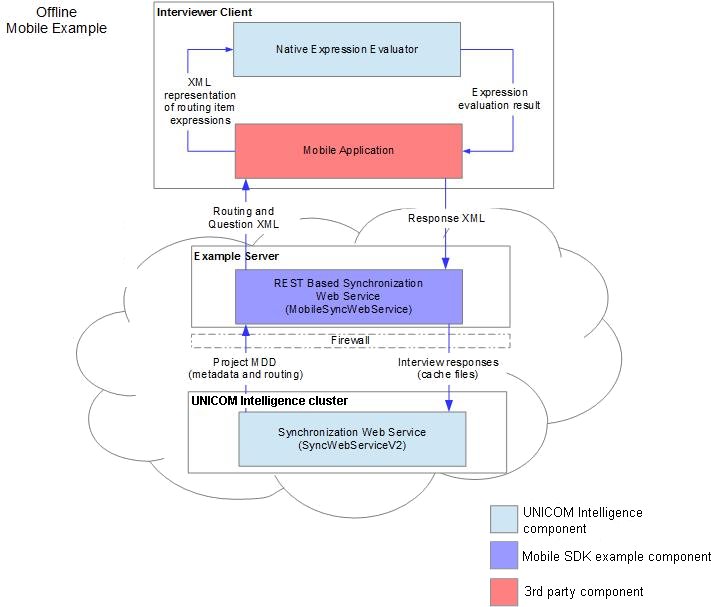Disconnected
This is a simplified view of the UNICOM Intelligence interviewing architecture, relevant to the disconnected implementation.
The personal interviewing steps are as follows:
Synchronizing project files to the UNICOM Intelligence Interviewer - Offline for Windows client
1 The interviewer logs on to the client workstation and initiates a synchronization.
2 The Interviewing Shell initiates a synchronization from the Synchronization Console.
3 The Synchronization Console authenticates the logged-in user with the SyncWebServiceV2.
4 The Synchronization Console downloads a compressed package of project files, that includes the interviewing script as a project *.mdd file.
Interviewing
1 The interviewer starts a new case for a new respondent.
2 The Interviewing Shell on the client works similarly to
mrIEng, as discussed in
Connected and partially connected. The Interviewing Shell sets up a data record for the respondent, loads the interview script, and runs the script to the first
Ask statement.
3 The Interviewing Shell uses the HTML Player to transform the Player XML to HTML.
4 The Interviewing Shell displays the HTML in an embedded browser.
5 The interviewer completes the interview page, and then submits the page.
6 The Interviewing Shell accepts the Post, and transforms the HTML into Player XML (which contains the response).
7 The Interviewing Shell passes the Player XML to the interview script, which handles the response and runs the routing script to the next Ask.
8 The process continues until the interview is complete. The data is stored in cache files (*.chj files) that are sent to the server and an UNICOM Intelligence Data Model data file. The file provides an overview of the respondent data to the interviewer.
Synchronizing respondent data to the UNICOM Intelligence cluster
1 The interviewer initiates a synchronization.
2 The Interviewing Shell initiates a synchronization from the Synchronization Console.
3 The Synchronization Console authenticates the logged in user with the SyncWebServiceV2.
4 The Synchronization Console creates and uploads a compressed package that contains cache files, log files, and other data that can be used for debugging.
5 The SyncServiceV2 confirms that the package was received successfully and saves it in an Inbox directory.
6 A background SyncServiceV2 worker thread scans the Inbox directory and processes the package.
7 The worker thread creates a serial number for the cache file. The serial number is unique for each respondent on the server.
8 The worker thread copies the cache file to the Cache directory.
Transferring respondent data to the merged respondent database.
The TransferService runs regularly and transfers all *.chj files in the Cache directory to the database. Data is now available for analysis.
More information
For more information regarding the synchronization steps, see
Synchronization process flow.
Component and data interaction provides information on the Interviewer information storage that is used for each type of data in the system. It is beneficial to understand the different storage types. However, the disconnected example converts all necessary file types to XML, which might be usable as-is.
Disconnected storage information
The following table outlines how the various disconnected artifacts are stored on both the client and the server.
Artifact | Client storage (API) | Server storage (API) |
|---|
Interview script (including questions and logic) | Project *.mdd (MDM) | Project *.mdd (MDM) |
Additional layout and formatting files | Template HTML, CSS, and images | Template HTML, CSS, and images |
Respondent case data | Cache file *.chj (Value Cache) | Cache file *.chj (Value Cache) Transferred to the SQL Server database (Data Model – RDB DSC) by the same process as Web interviews. |
Project settings | Project information *.xml | DPM |
Quota | Data Model tables (Data Model – UNICOM Intelligence DSC) | SQL tables (Quota) |
Sample | Data Model tables (Data Model – UNICOM Intelligence DSC) | SQL tables (SampleManagement) |
Debugging information | Log files (Data Model – Log DSC) | Log files (Data Model – Log DSC) |
The disconnected example is a REST based Synchronization Web Service (MobileSyncWebService) that provides a simplified set of URLs for synchronization. The example transforms each of the UNICOM Intelligence files to and from XML files. The web service is an example. However, you might find that the URL interface and XML files can be used directly in your mobile application.
This diagram illustrates the disconnected example architecture.
The disconnected example interacts with the SyncWebServiceV2 to synchronize files and does not include a fully working example (like the Connected example). You need to build a mobile application to manage projects and start interviews. Interviews are run by processing the Routing XML, to decide on the next question to ask, rendering the Question XML to the respondent, and gathering and storing the respondent input. This process is in addition to using or extending the provided example MobileSyncWebService.
See also


